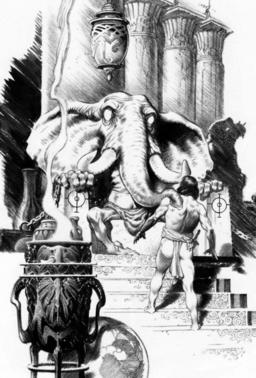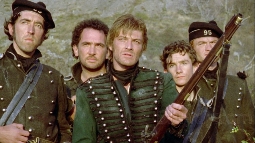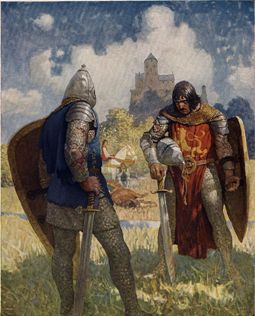Three Ways to Write a Cast of Supporting Characters Without Confusing the Reader

Remember the 1950s The Vikings? Tony Curtis versus Kirk Douglas. But what were their characters called?
How about Gladiator? Russel Crowe as Maximus. Can you remember the names of the other characters?
Pirates of the Caribbean? Johnny Depp as Captain Jack Sparrow. I bet you can name the other actors. What about their character names?
The nice thing about movies is that they have actors. Even if we don’t know their names, we do remember and then recognise them. So when Maximus’ right-hand man betrays him, we know who he is even if we can’t recall his name and didn’t realise how significant he was when we first saw him.
It’s harder with prose. Much, much, harder. As soon as you have more than a handful of characters, you’re faced with two problems: seeding and identifying.

By seeding I mean planting a character before they become significant. You know the kind of thing — nobody notices the butler until… The problem with this is that the reader doesn’t really see anything in the story not directly related to the conflict in hand, and doesn’t want to see it. If you serve up a quirky description of the butler, then they will most likely skim it.
Identifying — ensuring that the reader knows which character the you are talking about — should be easier. As long as the plot is in motion, the players are defined by their role in the conflicts: Evil Uncle, Envious Boss and so on.
Unfortunately it turns out that readers are mentally lazy. They — we! — need more than just a name and role to keep the track of who’s done what, especially if the story is all about politics and secret agendas.
How as a writer do you handle this?
#1 Avoid the Problem by Cutting the Number of Character Roles
Don’t name or fully characterise anybody who’s not going to be significant. Instead, reduce as many characters as possible to functional or group membership.
Remember Robert E Howard’s “The Tower of the Elephant?” In the tavern scene, there were a kidnapper, an insulting thief (deceased), some carousers. In the raid on the tower itself, there were generic guards. The result is an adventure set in a teeming city, and yet vividly focused on the conflict between thematic forces (Civilisation vs Idealised Barbarism), and featuring only four characters: Barbarian, Thief, Space Demon and Wizard.
The corollary of this is that when you do name or fully characterise a character, readers will assume that they will become significant. This can help with seeding. Don’t rely on it, though.
#2 Weave Characters Into the Story Conflicts

It bears repeating: Nothing is “real” to the reader unless it relates to a pressing conflict.
It follows that you can make a minor character real by making them useful in one of the protagonist’s (or antagonist’s) main conflicts.
For example, Cornwell’s Sharpe books bring-to-life his unit by assigning his men functions such as “Sharp shooter”, “Poacher” and “NCO”.
This can just be a way of making your story world feel populated, however it’s most useful when seeding. For example, if you want to draw attention to the butler, then have him act as a status symbol or gatekeeper in some conflict around class: “Miss Smith is not at home today… (wrinkles nose).., sir.”
Less obvious is that the main players need to be players out of the box. Don’t do introductions then start the conflict. Have Envious Boss comment on the protagonist’s youth and thus inexperience as soon as they meet. Otherwise, no matter how vivid your description, the boss will fade into the backdrop and become a generic colleague.
#3 Tag Like Crazy

This is the one where many authors fall down.
You assume that once we’ve got to know the characters, we’ll remember their name and thus if you mention their name, we’ll know who they are.
The problem is that we’re reading your book at 4 am after being woken by a baby, or at midday while recovering from a hangover, or on the tube train on the way to work.
A name is just not enough. You need to keep reminding us who the characters are, what they’ve done, and what they’re planning.
So, have Envious Boss still limping from the previous chapter’s mishap, remark that his cheerful demeanour is in contrast with his behavior on the office night out, and have somebody or something refer to his rank within the organisation. Have Rival Knight appear in a fresh surcoat, sporting a bruise, and vowing revenge for specific events.
Don’t be crass about it, though. Make the tag significant right now. Where possible, have any mere observations impact on decision: Hmmm, he survived being knocked off his horse without a scratch. Do I really want to fight him again? Better still, have the tags become ammunition in the main conflict: “I’m still your boss!”/ “Was that the best you could do?”
M Harold Page is the sword-wielding author of works such as Swords vs Tanks (Charles Stross: “Holy ****!”). For his take on writing, read Storyteller Tools: Outline from vision to finished novel without losing the magic. (Ken MacLeod: “…very useful in getting from ideas etc to plot and story.” Hannu Rajaniemi: “…find myself to coming back to [this] book in the early stages.”)
This is especially true when a character is introduced and then doesn’t reappear for 200 pages. I am unlikely to remember who they were and why they are significant. Doubly hard if there are character names which are similar to each other.
One of my favorite ways to make to make a large cast manageable for the reader is to use cognitive chunking to group the secondary characters and extras into clusters. Families, factions, professions, trades, classes, conspiracies, and locations are all useful for this trick.
I have an eight-piece band in one of my novels, and I’ve worked hard to make sure that the reader’s enjoyment and comprehension never depends on the ability to remember which musician is which. But for the reader who does have a knack or compulsion in that direction, I always have to keep track of those guys as individuals, so I can keep up a supply of grace notes (and attendant dopamine hits that readers get when they’re happy to have noticed a pattern).
I’ve also got a main character who’s terrible with names, so he keeps track of those guys by tagging them by instrument, by physical description, by temperament — the tall skinny guy who plays frame drum and likes to throw a punch, and the pimply-faced kid with a pocketful of tuned pennywhistles and a propensity for fart jokes. Every time my hero needs help keeping track of the boys in the band, the reader gets it, too.
[…] further reading, there’s a nice Black Gate post by author M. Harold Page (note his third point on character tagging) and a helpful post from writer […]